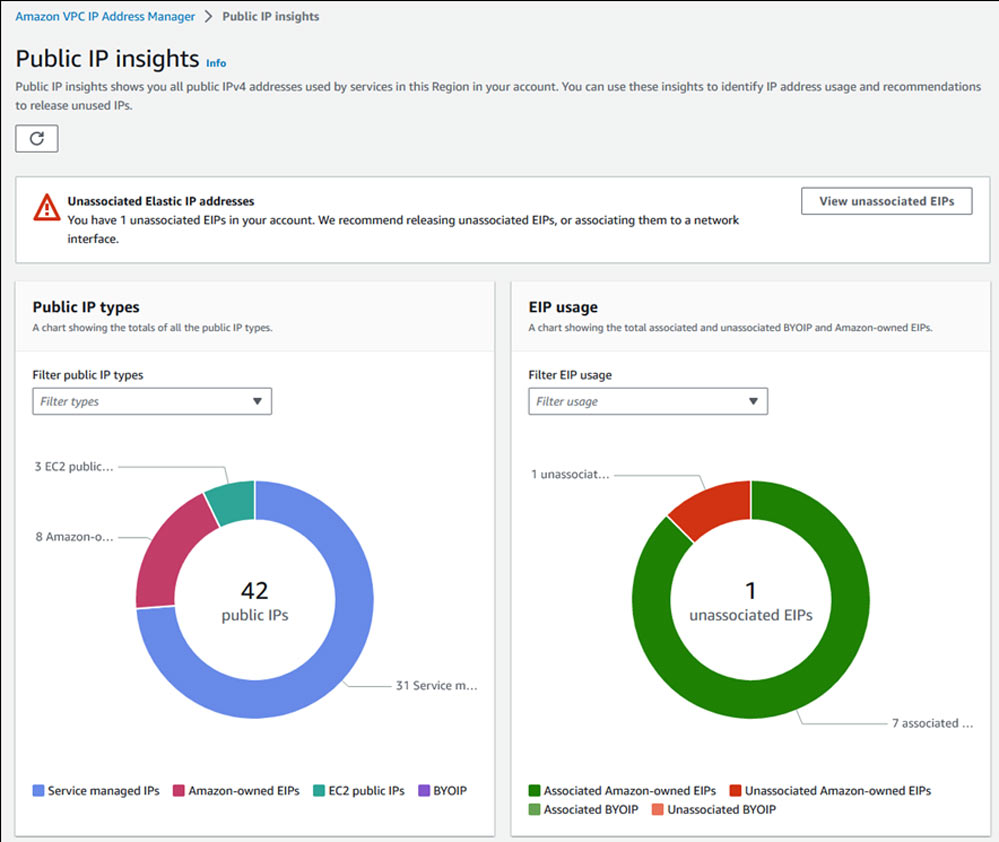Amazon’s new AWS charge for using IPv4 is expected to rake in up to $1B per year — change should speed IPv6 adoption
Charging $0.005 per IP per hour for all public IPv4 addresses quickly adds up.

On Thursday, Amazon Web Services (AWS) introduced a new charge for customers with public IPv4 addresses. It had warned that a new pricing plan would be put into place six months ago, and we had a rough idea of the scale of charges that many customers would face. However, the Border0 blog has spotlighted some very interesting financial implications of the change, estimating that Amazon will make as much as an extra $1 billion from its stable of IPv4 addresses over the coming year.
Last summer, we reported on the impending AWS IPv4 pricing change. Amazon said that starting February 1, 2024, it would start charging customers $0.005 per IP per hour for all public IPv4 addresses, whether attached to a service or not. It reasoned that IPv4 addresses are increasingly scarce and difficult to manage and explained that “the cost to acquire a single public IPv4 address has risen more than 300% over the past five years.” At the same time, it encouraged users to accelerate the adoption of IPv6.
So, $0.005 per IPv4 per hour sounds like a tiny amount, right? Previously, we worked out that it would mean a new fee of $43.80 per year per IPv4 address on an AWS service bill. Border0 has dived deeper into the figures and what the service pricing change could mean to AWS's income. It picked through data in the “AWS IP JSON and the various whois (ARIN, RIPE, etc.) data entries” to determine that Amazon has nearly 132 Million IPv4 addresses. Remember, we are told these addresses are in high demand / scarce, so it is reasonable to assume many are used by customers.
Combining the 132 million IPv4 addresses managed by AWS with ipv4.global data showing that the average price for an IPv4 address is currently ~35 dollars, Border0 calculated the total value of AWS IPv4 stock to be worth $4.6 billion.
The firm also considered the potential yearly income from these IPv4 addresses. Using a conservative estimate that 30% of AWS IPv4 stock (79 million IPv4 addresses) is in use by paying customers, Amazon would be able to rake in over a billion dollars a year from this internet real estate (23.7 million x $43.80 = $1.04 billion). The best guess of Border0 was that AWS would be making between $400 million and $1 billion a year from the IPv4 charging change implemented yesterday.
Go IPv6 if you can?
Why would Amazon want users to change to IPv6? IPv4 is a 32-bit addressing scheme and thus limited to 4.3 billion unique devices - not enough for the modern internet, IoT, and so on. IPv6 was created in 1998 and implements 128-bit addressing to provide approximately 340 undecillion addresses. That ought to be enough for anybody (sorry for recycling that joke from last time, but it was irresistible). As mentioned above, the scarcity of IPv4 addresses in 2024 means that there is a lot more effort needed to acquire, recycle, and manage them - so we have the new AWS IP address charging plan. However, AWS is not leveraging hourly charges on IPv6 addresses, and it provides tools for users to audit their IPv4 addresses, check where IPv6 addresses might be useful (several references), and release unused IPs.
Border0 also offers IP management solutions, including a free tier, which can potentially help you lower your AWS bill. If this charge structure change might affect you or your organization, you can read more about Border0’s services via their blog link in the intro.
Get Tom's Hardware's best news and in-depth reviews, straight to your inbox.

Mark Tyson is a news editor at Tom's Hardware. He enjoys covering the full breadth of PC tech; from business and semiconductor design to products approaching the edge of reason.
-
Rob_mc_1 IPv6 is not going to happen. Windows 2000 had native IPv6 support so it is not a client issue.Reply
Not all ISPs support IPv6. Bell Canada doesn't for example. What I see is the biggest hold up is Cable and DSL modems. Their firmware, UI and default settings is designed around IPv4. Most modems in use are already past their EOL. If they had to cut over to IPv6, new firmware would have to be pushed down to them. They would have to convince manufacturers to build new firmware for EOL devices. At the end of the day, ISPs would need to replace millions of devices overnight. No ISP will want to pay for that. I can't imagine the e-waste it would cause.
Another issue. Prefixes are assigned by an ISP. Have fun redoing you internal static addresses on you key devices if you change ISP. At least with NAT you can just drop in a replacement ISP.
Edit: One last note. Rural areas tend to get hand me down equipment when Cities get upgraded equipment. That is due to a low ROI on new infrastructure on for a handful of people. If there is an IPv6 cutover, there will be those without internet. -
greenreaper In the UK, it's Virgin Media that's the big blocker. That said, if some sites just aren't available over IPv4 then that could force their hand as it will become a competitive pressure.Reply
There will come a tipping point because it is now a non-trivial amount for a VM. Vultr is already offering IPv6-only VMs on its smallest plan for a $1/month discount, IIRC. -
Rob_mc_1 IReply
I could also see pressure go in the other direction. ISPs have their own data centers and won't be as phased by what AWS is doing. That instead will put pressure on people to secure IPv4 access or become irrelevant. As long as the average person can watch YouTube, buy things on Amazon or access Reddit and Wikipedia there will be little impact.greenreaper said:In the UK, it's Virgin Media that's the big blocker. That said, if some sites just aren't available over IPv4 then that could force their hand as it will become a competitive pressure.
There will come a tipping point because it is now a non-trivial amount for a VM. Vultr is already offering IPv6-only VMs on its smallest plan for a $1/month discount, IIRC. -
Daniel15 For hosting services, what it comes down to is that you really only need IPv4 on a limited number of edge nodes (load balancers and CDN nodes) that users directly connect to. Most servers aren't directly user-facing and would be fine only having an IPv6 address. This is what large companies like Google and Meta do - their internal network (both in their data centers and in their offices) are mostly IPv6-only.Reply
~40% of traffic to Google and ~37% of traffic to Facebook are going over IPv6 (https://www.google.com/intl/en/ipv6/statistics.html, https://www.facebook.com/ipv6/).Rob_mc_1 said:IPv6 is not going to happen
It really depends on where you live. It's mostly going great in the USA. Around 50% of traffic to Google and 60% of traffic to Facebook is going over IPv6. In the USA, most mobile networks are already IPv6-only, using 464XLAT and/or DNS64 for connectivity to legacy IPv4-only servers. They do NOT use CGNAT like in some other countries. T-mobile did this first, then some of the other carriers followed. Some aren't entirely IPv6 but they're 90%+ IPv6.
Comcast rolled out IPv6 way back in 2011. By 2015, 70% of their customers had IPv6 provisioned (https://corporate.comcast.com/comcast-voices/ipv4-depletion-not-the-beginning-of-the-end-its-just-the-end-of-the-beginning) and I think that's closer to 85% today. That means customers that actually have an active IPv6 prefix.
Rob_mc_1 said:What I see is the biggest hold up is Cable and DSL modems
Any modems from the past 5-10 years should support IPv6. I don't think any major ISPs (at least in the USA) are shipping modems that don't support IPv6 any more. If you're renting a modem from an ISP and it's very old, you can just ask them for a new one. That's one of the main reasons for renting a modem - you can upgrade it over time.
This is what ULAs (unique local addresses) are for. Your devices can have multiple IPv6 addresses, like a ULA for use within your network, and a public IP for internet access. Both of them can be assigned using SLAAC.Rob_mc_1 said:Another issue. Prefixes are assigned by an ISP. Have fun redoing you internal static addresses on you key devices if you change ISP. At least with NAT you can just drop in a replacement ISP.
NAT is a horrible hack and I'll be glad to see it gone. -
subspruce Reply
Windows 2000 is a server/enterprise OS, not a consumer one.Rob_mc_1 said:IPv6 is not going to happen. Windows 2000 had native IPv6 support so it is not a client issue.
Not all ISPs support IPv6. Bell Canada doesn't for example. What I see is the biggest hold up is Cable and DSL modems. Their firmware, UI and default settings is designed around IPv4. Most modems in use are already past their EOL. If they had to cut over to IPv6, new firmware would have to be pushed down to them. They would have to convince manufacturers to build new firmware for EOL devices. At the end of the day, ISPs would need to replace millions of devices overnight. No ISP will want to pay for that. I can't imagine the e-waste it would cause.
Another issue. Prefixes are assigned by an ISP. Have fun redoing you internal static addresses on you key devices if you change ISP. At least with NAT you can just drop in a replacement ISP.
Edit: One last note. Rural areas tend to get hand me down equipment when Cities get upgraded equipment. That is due to a low ROI on new infrastructure on for a handful of people. If there is an IPv6 cutover, there will be those without internet. -
greenreaper Reply
That was the intention, but I found it worked way better as a consumer OS for most purposes when I got my hands on a suspicious bootleg CD of it at school. Clearly MS had the same opinion when they brought it through to XP.subspruce said:Windows 2000 is a server/enterprise OS, not a consumer one.
